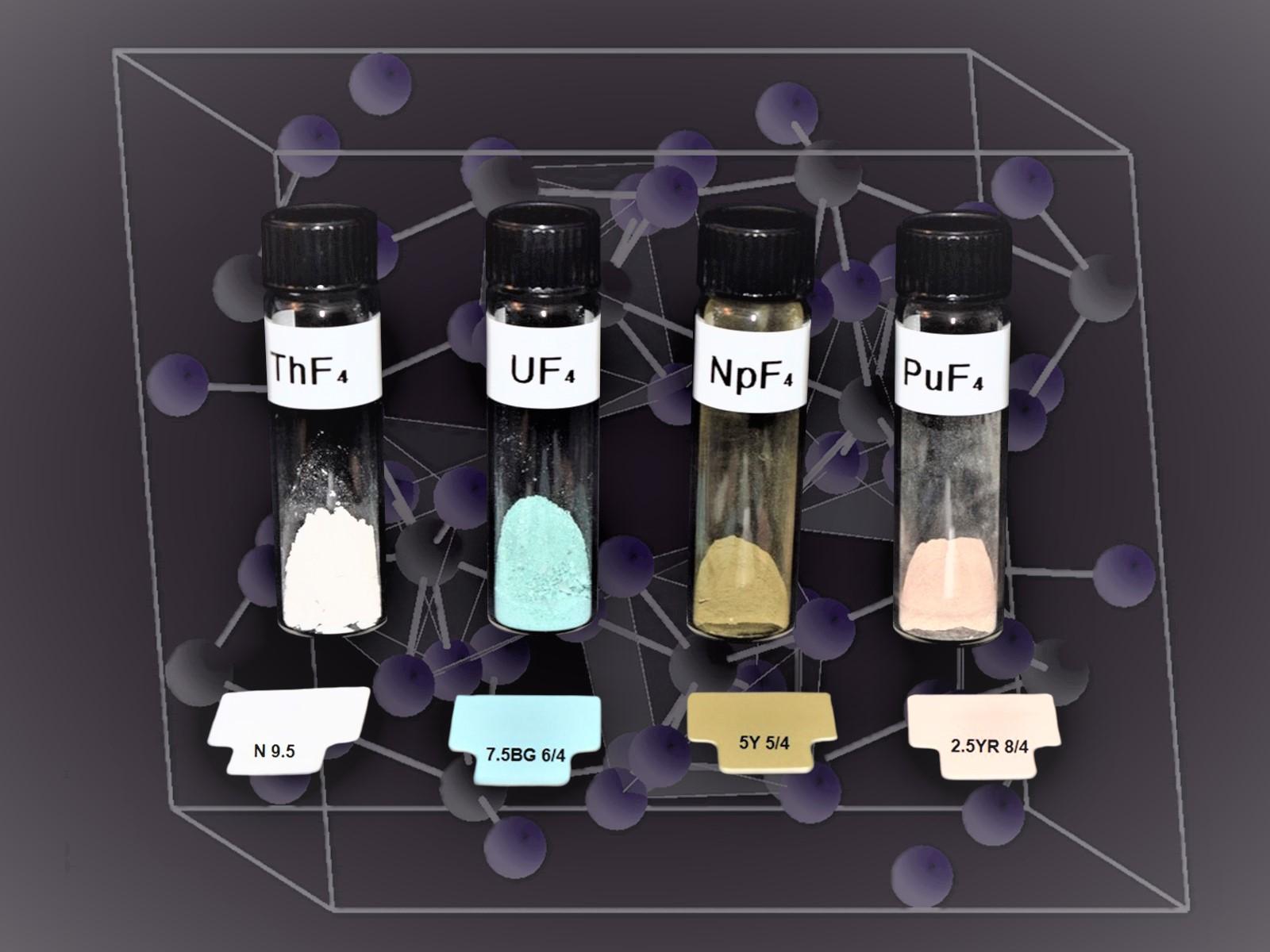The Remarkable Variability of Actinide Tetrafluoride Electronic Structures
Actinide tetrafluorides exhibit significant variations in their electronic structures despite having nearly identical crystal structures

Radioactive AnF4 powders display a range of colors, hinting at the variability in electronic structures that we can probe in detail by measuring local magnetic fields. Color swatches shown here are labeled according to the Munsell system.
(Composite image by Stephanie King | Pacific Northwest National Laboratory)
The Science
Scientists at Pacific Northwest National Laboratory synthesized tetrafluoride powders of four radioactive actinide elements (thorium, uranium, neptunium, and plutonium) and, through probes of their local magnetic fields, discovered remarkable variations in their electronic structures despite their nearly identical crystal structures. These studies reveal the transition of valence electrons from itinerant to localized behavior across the actinide row. This research provides a basis for the future studies of electronic configurations in other isostructural systems, which are important for the production of nuclear fuels and other energy-related technologies.
The Impact
Accurate descriptions of actinide element electronic structures are essential for understanding the physics and chemistry of next-generation nuclear fuels, novel superconductors, organometallic clusters, and radioactive waste. This study of an isostructural series of actinide compounds presents a new, systematic way of mapping the fascinating and distinctive evolution of electronic structure across the actinide row. Future studies will focus on developing theoretical descriptions that relate the experimental observations to the underlying electronic configurations of the metals.
Summary
Actinide elements, such as uranium and plutonium, play a leading role in energy and defense technologies. However, the scientific advances needed to realize the full potential of these technologies face complex theoretical issues in the analysis of heavy elements and more practical difficulties associated with the special measures required to manage the radioactivity hazard. In this study, researchers synthesized a series of radioactive actinide tetrafluoride (AnF4) powders. These elements (thorium, uranium, neptunium, and plutonium) bridge the heavy and light end of the actinide row and display identical crystal structures for the tetrafluoride form. Scientists then probed the AnF4 electronic structures by mapping the local fields using nuclear magnetic resonance spectroscopy. Spectroscopic experiments were performed in the Radiochemical Processing Laboratory Radiological Nuclear Magnetic Resonance Facility, which houses instrumentation customized for the analysis of radioactive samples, including two nuclear magnetic resonance spectrometers and a broadband nuclear quadrupole resonance spectrometer. This work can be used a guide for future electron correlation studies of f-block elements.
Contact
Herman Cho
Physical and Computational Sciences Directorate, Pacific Northwest National Laboratory
hm.cho@pnnl.gov
Funding
This work was supported by the U.S. Department of Energy Office of Science, Basic Energy Sciences program, Division of Chemical Sciences, Geosciences and Biosciences, Heavy Element Chemistry program.
Published: June 2, 2021
Eric D. Walter, Cigdem Capan, Amanda J. Casella, Jennifer C. Carter, Bruce K. McNamara, Chuck Z. Soderquist, Sergey I. Sinkov, Richard A. Clark, Forrest D. Heller, Lucas E. Sweet, Jordan F. Corbey, Herman Cho. Measurement of Local Magnetic Fields in Actinide Tetrafluorides. Journal of Chemical Physics. DOI: 10.1063/5.0052323